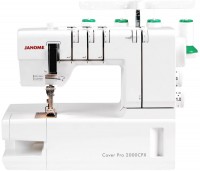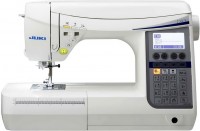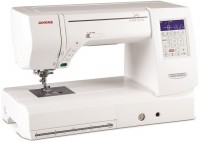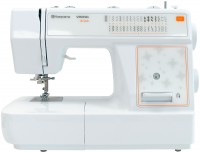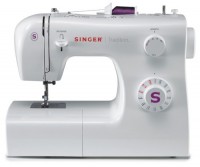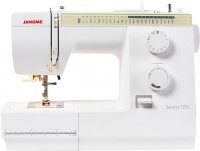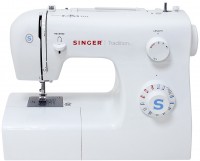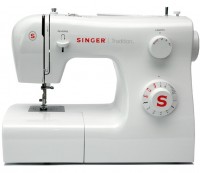Sewing Machines & Overlockers Brother
All models Advanced filters → |
You might be interested in
Sewing Machines & Overlockers: specifications, types
Type of sewing machine
The general type of sewing machine, which determines its functionality and specific application.
— Electromechanical. The classic, simplest type of sewing machines: they do not have computer control, all operating parameters are adjusted mechanically, and their use is limited to the simplest types of seams.
- Computerized. Sewing machines equipped with built-in computers that control the sewing process. Thanks to this, they have a more extensive set of functions and are more precise in setting than electromechanical ones, although they cost accordingly. Note that in this case we mean exclusively computerized sewing machines; embroidery and sewing-embroidery machines are divided into separate categories (see the corresponding paragraphs).
— Embroidery. Such machines were initially intended only for embroidering patterns, and are practically not suitable for work outside this specialization (regular sewing, hemming). They have appropriate design features, are equipped with a hoop and embroidery feet, and are often equipped with both a set of built-in presets (for example, embroidering letters of the alphabet) and the ability to connect to a PC and download patterns.
— Sewing and embroidery. Machines that can be used for both sewing and embroidery. The design and sewing capabilities are similar to computerized...models (see the corresponding paragraph), but are complemented by an embroidery unit, hoop and other embroidery equipment. And the built-in capabilities usually include both basic embroidery elements (crosses, stars, satin stitch, etc.) and the ability to embroider using patterns downloaded from a computer. Such machines are very versatile, but in terms of specific capabilities they may be inferior to more specialized models.
— Overlock. A special type of sewing machine designed primarily for seaming and trimming the edges of materials. An overlocker covers the edge of the fabric with a special seam, which prevents fraying, fraying and deformation. One of the design features of such devices is the presence of several working threads, from 2 to 10 (most often 3 or 4).
— Coverstitching machine. Devices designed to create the so-called. cover stitch - a flat elastic seam that is most often used to hem the folded edge in knitwear, as well as in some types of joints. Such machines are not used for other purposes.
— Coverlock. Devices that combine an overlocker and a cover stitching machine in one housing. For more information about each of these varieties, see the corresponding paragraph. Here we note that a carpet lock is actually a universal tool for processing edges: it is capable of overcasting them, cutting off excess fabric and hemming the folded edge with a cover stitch. In addition, many modern carpet stitchers are also capable of stitching materials (mainly with a two-thread chain stitch).
— Electromechanical. The classic, simplest type of sewing machines: they do not have computer control, all operating parameters are adjusted mechanically, and their use is limited to the simplest types of seams.
- Computerized. Sewing machines equipped with built-in computers that control the sewing process. Thanks to this, they have a more extensive set of functions and are more precise in setting than electromechanical ones, although they cost accordingly. Note that in this case we mean exclusively computerized sewing machines; embroidery and sewing-embroidery machines are divided into separate categories (see the corresponding paragraphs).
— Embroidery. Such machines were initially intended only for embroidering patterns, and are practically not suitable for work outside this specialization (regular sewing, hemming). They have appropriate design features, are equipped with a hoop and embroidery feet, and are often equipped with both a set of built-in presets (for example, embroidering letters of the alphabet) and the ability to connect to a PC and download patterns.
— Sewing and embroidery. Machines that can be used for both sewing and embroidery. The design and sewing capabilities are similar to computerized...models (see the corresponding paragraph), but are complemented by an embroidery unit, hoop and other embroidery equipment. And the built-in capabilities usually include both basic embroidery elements (crosses, stars, satin stitch, etc.) and the ability to embroider using patterns downloaded from a computer. Such machines are very versatile, but in terms of specific capabilities they may be inferior to more specialized models.
— Overlock. A special type of sewing machine designed primarily for seaming and trimming the edges of materials. An overlocker covers the edge of the fabric with a special seam, which prevents fraying, fraying and deformation. One of the design features of such devices is the presence of several working threads, from 2 to 10 (most often 3 or 4).
— Coverstitching machine. Devices designed to create the so-called. cover stitch - a flat elastic seam that is most often used to hem the folded edge in knitwear, as well as in some types of joints. Such machines are not used for other purposes.
— Coverlock. Devices that combine an overlocker and a cover stitching machine in one housing. For more information about each of these varieties, see the corresponding paragraph. Here we note that a carpet lock is actually a universal tool for processing edges: it is capable of overcasting them, cutting off excess fabric and hemming the folded edge with a cover stitch. In addition, many modern carpet stitchers are also capable of stitching materials (mainly with a two-thread chain stitch).
Shuttle
The type of shuttle provided in the design of the sewing machine.
The shuttle is a device for feeding the lower thread; This is where the bobbin and thread is inserted. The following types of shuttles are found in modern machines:
- Rocking. Swinging shuttles have only a vertical layout. This is a simple, inexpensive and at the same time reliable mechanism, which also makes the device almost “omnivorous”: many models with swinging shuttles are able to cope with thick, coarse fabrics that are “too tough” for other types of machines. In addition, in such a shuttle it is very easy to adjust the method of thread tension. Among the disadvantages of this option, it is worth noting the increased level of vibration and noise, relatively low speed, as well as a more complex threading procedure than in horizontal shuttles.
— Vertical rotational. In a number of features, such shuttles are similar to swinging shuttles (see the corresponding paragraph): in particular, they are relatively simple to adjust the thread tension, but to thread the bobbin you must every time reach into the mechanism and remove the bobbin case from the shuttle. The key difference is that the shuttle does not swing during operation, but rotates. Because of this, such mechanisms are somewhat more complex and more expensive than swinging ones, but they provide higher sewing speeds with lower levels of vibration and noise....This option is used in professional and semi-professional machines, as well as industrial equipment.
— Horizontal rotational. Shuttles of this type are easy to use: to thread the bobbin thread, you do not need to remove the bobbin case; just open the cover and install the bobbin directly into the shuttle. In addition, the top cover is often made transparent, which allows you to monitor the remainder of the lower thread. Moreover, due to the rotational principle of operation, such a shuttle provides good speed and a minimum level of vibration and noise. Among the disadvantages of this option, one can note the difficulty in adjusting the thread tension: to do this, as a rule, you have to unscrew several bolts and remove the entire shuttle (whereas in vertical mechanisms the regulator is located on a quickly removable bobbin head). In addition, horizontal shuttles are not suitable for constant sewing with coarse threads - such a thread can rub a groove in the body, after which the mechanism will have to be changed.
The shuttle is a device for feeding the lower thread; This is where the bobbin and thread is inserted. The following types of shuttles are found in modern machines:
- Rocking. Swinging shuttles have only a vertical layout. This is a simple, inexpensive and at the same time reliable mechanism, which also makes the device almost “omnivorous”: many models with swinging shuttles are able to cope with thick, coarse fabrics that are “too tough” for other types of machines. In addition, in such a shuttle it is very easy to adjust the method of thread tension. Among the disadvantages of this option, it is worth noting the increased level of vibration and noise, relatively low speed, as well as a more complex threading procedure than in horizontal shuttles.
— Vertical rotational. In a number of features, such shuttles are similar to swinging shuttles (see the corresponding paragraph): in particular, they are relatively simple to adjust the thread tension, but to thread the bobbin you must every time reach into the mechanism and remove the bobbin case from the shuttle. The key difference is that the shuttle does not swing during operation, but rotates. Because of this, such mechanisms are somewhat more complex and more expensive than swinging ones, but they provide higher sewing speeds with lower levels of vibration and noise....This option is used in professional and semi-professional machines, as well as industrial equipment.
— Horizontal rotational. Shuttles of this type are easy to use: to thread the bobbin thread, you do not need to remove the bobbin case; just open the cover and install the bobbin directly into the shuttle. In addition, the top cover is often made transparent, which allows you to monitor the remainder of the lower thread. Moreover, due to the rotational principle of operation, such a shuttle provides good speed and a minimum level of vibration and noise. Among the disadvantages of this option, one can note the difficulty in adjusting the thread tension: to do this, as a rule, you have to unscrew several bolts and remove the entire shuttle (whereas in vertical mechanisms the regulator is located on a quickly removable bobbin head). In addition, horizontal shuttles are not suitable for constant sewing with coarse threads - such a thread can rub a groove in the body, after which the mechanism will have to be changed.
Loop formation
A method of forming slotted loops supported by a machine.
— Automatic. Fully automatic buttonhole sewing mode; the user only needs to set the length, after which the machine will independently process the edges of the future loop, without the need to switch modes manually. The most convenient and advanced option; It is the automatic method that is recommended if you plan to sew a large number of loops.
— Semi-automatic. When forming a loop in this way, the work is done in 2 or 4 steps. For example, in the first case, the machine makes one short bartack and one long longitudinal stitch in one pass, then the mode switches and a second bartack and a second long stitch are performed; in the second case, accordingly, you have to switch between 4 stages. Such work takes more time than automatic loop formation, but such machines are cheaper.
— Automatic. Fully automatic buttonhole sewing mode; the user only needs to set the length, after which the machine will independently process the edges of the future loop, without the need to switch modes manually. The most convenient and advanced option; It is the automatic method that is recommended if you plan to sew a large number of loops.
— Semi-automatic. When forming a loop in this way, the work is done in 2 or 4 steps. For example, in the first case, the machine makes one short bartack and one long longitudinal stitch in one pass, then the mode switches and a second bartack and a second long stitch are performed; in the second case, accordingly, you have to switch between 4 stages. Such work takes more time than automatic loop formation, but such machines are cheaper.
Number of stitches
The number of stitches that a sewing machine can sew. The larger this number, the more extensive the capabilities of this model, the wider the choice the user has; however, it wouldn’t hurt to clarify the specific range of supported stitches separately.
The fewest options - mostly up to 25 - are provided in electromechanical machines, as well as specialized devices such as overlockers and carpet lockers (see “Type”). In computer-controlled devices, the number of lines can be in the dozens, and some also allow you to download additional options from the computer.
The fewest options - mostly up to 25 - are provided in electromechanical machines, as well as specialized devices such as overlockers and carpet lockers (see “Type”). In computer-controlled devices, the number of lines can be in the dozens, and some also allow you to download additional options from the computer.
Number of loops
The number of welt stitches that a sewing machine can make. Different types of loops are used for different types of fabrics and clothing. The larger this number, the wider the choice the user has and the less likely it is that the machine’s arsenal will not have the required type of loop.
Max. stitch length
The maximum stitch length that the sewing machine can sew. This parameter is important for working with dense thick fabrics: the stronger the fabric, the longer the seam used for it. Accordingly, the longer the stitch ( 5 mm or more), the better the machine is suitable for working with similar fabrics.
Max. stitch width
The maximum stitch width provided by a sewing machine.
Most modern sewing machines are capable of working not only with the simplest longitudinal seam (when punctures with a needle occur strictly one after another), but also with seams that cover a certain width - for example, zigzag and various decorative ones. And in overlockers, such opportunities are generally available by definition.
The larger the maximum stitch width, the correspondingly wider the machine’s ability to work with specific types of seams (all other things being equal). An indicator of up to 5 mm is typical mainly for entry-level devices, 5 - 7 mm - average, 7 mm and more - advanced.
Most modern sewing machines are capable of working not only with the simplest longitudinal seam (when punctures with a needle occur strictly one after another), but also with seams that cover a certain width - for example, zigzag and various decorative ones. And in overlockers, such opportunities are generally available by definition.
The larger the maximum stitch width, the correspondingly wider the machine’s ability to work with specific types of seams (all other things being equal). An indicator of up to 5 mm is typical mainly for entry-level devices, 5 - 7 mm - average, 7 mm and more - advanced.
Max. presser foot height
Distance from the working surface to the foot in the uppermost position. Must be taken into account when working with thick fabrics.
Sewing speed
The maximum sewing speed provided by the sewing machine. In the vast majority of models, this parameter can be adjusted, so if necessary, you can sew at a lower speed.
The more stitches a machine makes per minute, the higher its productivity, the better suited it is for large volumes of work. At the same time, it is worth considering that high speed has a corresponding impact on price and energy consumption, and it is not always required. Detailed recommendations on choosing the optimal speed for certain types of work can be found in special sources.
The more stitches a machine makes per minute, the higher its productivity, the better suited it is for large volumes of work. At the same time, it is worth considering that high speed has a corresponding impact on price and energy consumption, and it is not always required. Detailed recommendations on choosing the optimal speed for certain types of work can be found in special sources.
Features
— Вышивание букв алфавита. Возможность вышивания букв алфавита с помощью машинки. Данная функция встречается в моделях с компьютерным управлением, она осуществляется за счет набора букв, занесенного в память машинки. Многие модели с такой возможностью имеют несколько встроенных шрифтов, а некоторые даже позволяют загружать свои шрифты с компьютера.
— Дифференциальный транспортер. Транспортер для ткани, состоящий из двух зубчатых реек — перед и за иглой. В зависимости от выставленного режима такой транспортер может дополнительно растягивать или, наоборот, собирать ткань во время шитья; первое пригодится при работе с плотными тканями, второе — для трикотажа, стрейча и других легко тянущихся материалов.
— Реверс. Функция, позволяющая переключать направление движения ткани под иглой и, соответственно, направление шва. Применяется в основном для закрепления строчки. Реверс является практически обязательным для швейных машин в классическом смысле слова — электромеханических, компьютеризированных и швейно-вышивальных (см. «Тип»), а вот в других типах практически не встречается.
— Рукавная платформа. Приспособление для работы с рукавами, штанинами и прочими аналогичными деталями одежды. Эта функция чаще всего реализуется за счет съемной части рабочего столика — при ее снятии столик превращается в узкую платформу. Конкретная ширина такого прис...пособления может быть разной, ее стоит уточнять отдельно.
— Нитевдеватель. Специальное приспособление, предназначенное для того, чтобы облегчить процесс вдевания нитки в иголку. Наличие нитевдевателя особенно полезно при частной смене ниток (например, шитье попеременно разными цветами).
— Нитеобрезатель. Механизм для обрезания нитей после окончания шитья, избавляющий от необходимости использовать ножницы: для обрезания нитки достаточно нажать кнопку. Отметим, что речь идет именно об автоматическом нитеобрезателе; ручные приспособления, устанавливаемые на корпуса некоторых машинок, в данном случае нитеобрезателями не считаются.
— Шитье без педали. Возможность использовать машинку без подключения педали. Для запуска и остановки процесса в таких моделях, как правило, предусматривается специальная кнопка. Подобная возможность может пригодиться при длительном шитье, когда держать педаль постоянно нажатой было бы утомительно, и при эпизодическом использовании, когда машинка запускается «на пару стежков» и возиться с подключением педали особо незачем.
— Шитье двойной иглой. Возможность применения машинки для шитья двойной иглой — парой игл, закрепленных в одном держателе. Существуют разные виды таких игл и разные приемы работы с ними, а некоторые работы выполняются только двойной иглой. В любом случае для использования подобных приспособлений требуется, чтобы машинка была изначально с ними совместима.
— Позиционирование иглы (верх/низ). Переключатель, позволяющий пользователю выбрать, в каком положении будет находиться игла после остановки двигателя — верхнем или нижнем. При отсутствии такого выключателя игла, как правило, останавливается только в верхнем положении, а это не всегда удобно
— Дифференциальный транспортер. Транспортер для ткани, состоящий из двух зубчатых реек — перед и за иглой. В зависимости от выставленного режима такой транспортер может дополнительно растягивать или, наоборот, собирать ткань во время шитья; первое пригодится при работе с плотными тканями, второе — для трикотажа, стрейча и других легко тянущихся материалов.
— Реверс. Функция, позволяющая переключать направление движения ткани под иглой и, соответственно, направление шва. Применяется в основном для закрепления строчки. Реверс является практически обязательным для швейных машин в классическом смысле слова — электромеханических, компьютеризированных и швейно-вышивальных (см. «Тип»), а вот в других типах практически не встречается.
— Рукавная платформа. Приспособление для работы с рукавами, штанинами и прочими аналогичными деталями одежды. Эта функция чаще всего реализуется за счет съемной части рабочего столика — при ее снятии столик превращается в узкую платформу. Конкретная ширина такого прис...пособления может быть разной, ее стоит уточнять отдельно.
— Нитевдеватель. Специальное приспособление, предназначенное для того, чтобы облегчить процесс вдевания нитки в иголку. Наличие нитевдевателя особенно полезно при частной смене ниток (например, шитье попеременно разными цветами).
— Нитеобрезатель. Механизм для обрезания нитей после окончания шитья, избавляющий от необходимости использовать ножницы: для обрезания нитки достаточно нажать кнопку. Отметим, что речь идет именно об автоматическом нитеобрезателе; ручные приспособления, устанавливаемые на корпуса некоторых машинок, в данном случае нитеобрезателями не считаются.
— Шитье без педали. Возможность использовать машинку без подключения педали. Для запуска и остановки процесса в таких моделях, как правило, предусматривается специальная кнопка. Подобная возможность может пригодиться при длительном шитье, когда держать педаль постоянно нажатой было бы утомительно, и при эпизодическом использовании, когда машинка запускается «на пару стежков» и возиться с подключением педали особо незачем.
— Шитье двойной иглой. Возможность применения машинки для шитья двойной иглой — парой игл, закрепленных в одном держателе. Существуют разные виды таких игл и разные приемы работы с ними, а некоторые работы выполняются только двойной иглой. В любом случае для использования подобных приспособлений требуется, чтобы машинка была изначально с ними совместима.
— Позиционирование иглы (верх/низ). Переключатель, позволяющий пользователю выбрать, в каком положении будет находиться игла после остановки двигателя — верхнем или нижнем. При отсутствии такого выключателя игла, как правило, останавливается только в верхнем положении, а это не всегда удобно
Adjustments
— Регулировка давления лапки. Возможность изменять степень давления лапки на ткань, подстраивая ее под толщину материала: для тонких тканей (шифон, трикотаж) давление должно быть небольшим, для толстых — наоборот.
— Регулятор натяжения нити. Приспособление, позволяющее регулировать степень натяжения верхней нити. Несогласование по натяжению между верхней и нижней нитью приводит к тому, что одна из ниток вытягивает другую и шов портится; для избежания этого явления и предусматривается данная функция. Отметим, что регулировка натяжения возможна и для нижней нити — она осуществляется через челнок (такую возможность имеют все челноки). Но для этого необходимо вынимать шпульный колпачок, а то и весь челнок целиком. Верхний же регулятор располагается прямо на корпусе машинки, и пользоваться им значительно проще.
— Стабилизатор усилия прокола. Приспособление, которое обеспечивает стабильное усилие прокола независимо от скорости работы двигателя. Особенность механики электродвигателей заключается в том, что без специальной регулировки усилие прокола заметно снижается при росте оборотов. Данная же функция позволяет поддерживать приблизительно одинаковый уровень на всем диапазоне скоростей, что положительно сказывается на качестве работы.
— Отключение нижнего транспортера. Возможность отключить нижний транспортер машинки. Д...анная особенность незаменима для работ, при которых ткань нужно смещать вручную — например, вышивки по сложному контуру на машинке без вышивального блока, пришивании пуговиц и т.п.
— Ограничитель скорости. Возможность задать ограничение по скорости работы машинки. Благодаря этой функции можно не бояться «пережать» педаль — даже при сильном нажиме машинка будет работать с заданной скоростью, и не быстрее. Данная особенность бывает полезна, в частности, при работах, где требуется внимательно контролировать процесс.
— Коленный рычаг подъема лапки. Приспособление, позволяющее поднимать лапку и опускать нижний транспортер движением колена, не снимая рук с ткани. Такое приспособление бывает полезно при квилтинге и некоторых разновидностях вышивки.
— Регулятор натяжения нити. Приспособление, позволяющее регулировать степень натяжения верхней нити. Несогласование по натяжению между верхней и нижней нитью приводит к тому, что одна из ниток вытягивает другую и шов портится; для избежания этого явления и предусматривается данная функция. Отметим, что регулировка натяжения возможна и для нижней нити — она осуществляется через челнок (такую возможность имеют все челноки). Но для этого необходимо вынимать шпульный колпачок, а то и весь челнок целиком. Верхний же регулятор располагается прямо на корпусе машинки, и пользоваться им значительно проще.
— Стабилизатор усилия прокола. Приспособление, которое обеспечивает стабильное усилие прокола независимо от скорости работы двигателя. Особенность механики электродвигателей заключается в том, что без специальной регулировки усилие прокола заметно снижается при росте оборотов. Данная же функция позволяет поддерживать приблизительно одинаковый уровень на всем диапазоне скоростей, что положительно сказывается на качестве работы.
— Отключение нижнего транспортера. Возможность отключить нижний транспортер машинки. Д...анная особенность незаменима для работ, при которых ткань нужно смещать вручную — например, вышивки по сложному контуру на машинке без вышивального блока, пришивании пуговиц и т.п.
— Ограничитель скорости. Возможность задать ограничение по скорости работы машинки. Благодаря этой функции можно не бояться «пережать» педаль — даже при сильном нажиме машинка будет работать с заданной скоростью, и не быстрее. Данная особенность бывает полезна, в частности, при работах, где требуется внимательно контролировать процесс.
— Коленный рычаг подъема лапки. Приспособление, позволяющее поднимать лапку и опускать нижний транспортер движением колена, не снимая рук с ткани. Такое приспособление бывает полезно при квилтинге и некоторых разновидностях вышивки.
Embroidery unit
Наличие в машинке вышивального блока — дополнительного приспособления в виде платформы с пяльцами, которые способны двигаться под иглой в разные стороны. В соответствии с названием, такой блок позволяет в автоматическом режиме вышивать различные узоры и рисунки.
Max. embroidery area
Максимальный размер области, которую машинка в режиме вышивания может обработать за один раз, без перенатягивания ткани на пяльцы. Иными словами, это максимальный размер рисунка, который устройство может вышить «за один заход».
Смысл данного параметра очевиден: он позволяет оценить, подойдёт ли выбранная модель для вышивки рисунков запланированного размера.
Смысл данного параметра очевиден: он позволяет оценить, подойдёт ли выбранная модель для вышивки рисунков запланированного размера.
Number of embroidery patterns
The number of embroidery patterns supported by the machine.
In this case, usually, it means the number of drawings that can be simultaneously written to the device's memory and stored there. The more diverse the planned embroidery work, the more memory is desirable for them. However, in modern models, the number of drawings often reaches several dozen.
In this case, usually, it means the number of drawings that can be simultaneously written to the device's memory and stored there. The more diverse the planned embroidery work, the more memory is desirable for them. However, in modern models, the number of drawings often reaches several dozen.
Number of hoops
The number of hoops supplied with the machine.
The presence of several hoops in the kit allows you to minimize interruptions in work: while the machine is embroidering on some hoops, you can fasten the next workpiece to others, and after embroidering, you can quickly replace the hoops.
The presence of several hoops in the kit allows you to minimize interruptions in work: while the machine is embroidering on some hoops, you can fasten the next workpiece to others, and after embroidering, you can quickly replace the hoops.
Presser foots
Виды лапок, поставляемых в комплекте со швейной машинкой.
— Универсальная. Лапка, используемая для стандартных швейных операций — преимущественно прямых строчек и зигзагов.
— Лапка оверлочная. Лапка, предназначенная для выполнения оверлочной обработки. По определению встречается в устройствах с функцией оверлока (см. «Тип»), однако может предусматриваться и в традиционных швейных машинках. В последнем случае такая лапка, разумеется, не заменит полноценного оверлока, однако в некоторых ситуациях она позволяет обойтись без него.
— Верхний транспортер ткани. Дополнительный транспортер для ткани, устанавливаемый сверху, вместо штатной лапки в дополнение к стандартному нижнему транспортеру. Такое приспособление облегчает работу с тонкими, деликатными и скользящими тканями, а также сшивание вместе нескольких слоев ткани: материал сдвигается максимально равномерно, без перекосов и смещений.
— Лапка для вшивания молнии. Лапки для вшивания молнии могут иметь разный размер и конструкцию — в частности, существуют специальные приспособления для вшивания потайной молнии. Конкретные особенности данного приспособления стоит уточнять отдельно.
— Лапка для декоративной строчки. Лапки, предназначенные для различных разновидностей декоративной строчки. Такая строчка может и не иметь функциональной...роли, ее основная задача — подчеркнуть определенный элемент одежды (края, карманы, отдельные швы и т. п.). В любом случае линия стежков обычно должна строго следовать контуру, вдоль которого она наносится — а этот контур может состоять как из прямых, так и из кривых линий. Специальные лапки для декоративной строчки упрощают задачу: они оснащаются линейками или другими приспособлениями, позволяющими контролировать параллельность стежков.
— Лапка для атласной строчки. Данная лапка будет пригодна для аппликаций и другой работы, где часто используется зигзагоподобные стежки.
— Лапка для потайной строчки. Лапка, предназначенная для потайных швов, применяемых при подгибании края ткани. Оснащается приспособлением, которое обеспечивает подгиб ткани и в таком положении подает ее под иглу.
— Лапка для квилтинга. Специальные лапки для выполнения квилтинга — лоскутного шитья. При таких работах приходится сшивать ткань в несколько слоев, а также выполнять фигурные швы. В крайнем случае для квилтинга можно применять и обычную универсальную лапку, но пользоваться специальным приспособлением все же значительно удобнее.
— Лапка для вышивания монограмм. Лапка для вышивания монограмм позволит сделать вышивку на любом объекте, тем самым «украсив» его своей подписью или же эмблемой какого-либо учреждения, фирмы, спортивного клуба.
— Лапка для выметывания петли. Лапка, предназначенная для образования петель. С ее помощью отпадает надобность в ручной работе. Все за вас сделает швейная машинка, что и время сократит, и качеством порадует.
— Лапка для пришивания пуговиц. Лапка, предназначенная для фиксации пуговицы на ткани во время пришивания. Имеет специальный выступ, направленный вниз: когда основная часть лапки прижимается к пуговице, этот выступ прижимает ткань и предотвращает ее скольжение.
Кроме вышеназванных, в комплект поставки могут включаться и другие виды лапок — например, для атласной строчки, для обработки срезов и т.п.
— Универсальная. Лапка, используемая для стандартных швейных операций — преимущественно прямых строчек и зигзагов.
— Лапка оверлочная. Лапка, предназначенная для выполнения оверлочной обработки. По определению встречается в устройствах с функцией оверлока (см. «Тип»), однако может предусматриваться и в традиционных швейных машинках. В последнем случае такая лапка, разумеется, не заменит полноценного оверлока, однако в некоторых ситуациях она позволяет обойтись без него.
— Верхний транспортер ткани. Дополнительный транспортер для ткани, устанавливаемый сверху, вместо штатной лапки в дополнение к стандартному нижнему транспортеру. Такое приспособление облегчает работу с тонкими, деликатными и скользящими тканями, а также сшивание вместе нескольких слоев ткани: материал сдвигается максимально равномерно, без перекосов и смещений.
— Лапка для вшивания молнии. Лапки для вшивания молнии могут иметь разный размер и конструкцию — в частности, существуют специальные приспособления для вшивания потайной молнии. Конкретные особенности данного приспособления стоит уточнять отдельно.
— Лапка для декоративной строчки. Лапки, предназначенные для различных разновидностей декоративной строчки. Такая строчка может и не иметь функциональной...роли, ее основная задача — подчеркнуть определенный элемент одежды (края, карманы, отдельные швы и т. п.). В любом случае линия стежков обычно должна строго следовать контуру, вдоль которого она наносится — а этот контур может состоять как из прямых, так и из кривых линий. Специальные лапки для декоративной строчки упрощают задачу: они оснащаются линейками или другими приспособлениями, позволяющими контролировать параллельность стежков.
— Лапка для атласной строчки. Данная лапка будет пригодна для аппликаций и другой работы, где часто используется зигзагоподобные стежки.
— Лапка для потайной строчки. Лапка, предназначенная для потайных швов, применяемых при подгибании края ткани. Оснащается приспособлением, которое обеспечивает подгиб ткани и в таком положении подает ее под иглу.
— Лапка для квилтинга. Специальные лапки для выполнения квилтинга — лоскутного шитья. При таких работах приходится сшивать ткань в несколько слоев, а также выполнять фигурные швы. В крайнем случае для квилтинга можно применять и обычную универсальную лапку, но пользоваться специальным приспособлением все же значительно удобнее.
— Лапка для вышивания монограмм. Лапка для вышивания монограмм позволит сделать вышивку на любом объекте, тем самым «украсив» его своей подписью или же эмблемой какого-либо учреждения, фирмы, спортивного клуба.
— Лапка для выметывания петли. Лапка, предназначенная для образования петель. С ее помощью отпадает надобность в ручной работе. Все за вас сделает швейная машинка, что и время сократит, и качеством порадует.
— Лапка для пришивания пуговиц. Лапка, предназначенная для фиксации пуговицы на ткани во время пришивания. Имеет специальный выступ, направленный вниз: когда основная часть лапки прижимается к пуговице, этот выступ прижимает ткань и предотвращает ее скольжение.
Кроме вышеназванных, в комплект поставки могут включаться и другие виды лапок — например, для атласной строчки, для обработки срезов и т.п.
Display
The sewing machine has its own display. It can be either the simplest segment screen capable of displaying 2-3 characters, or a matrix of pixels, which can display not only inscriptions, but also graphic information — pictures, diagrams, progress indicators, etc. Anyway, this function makes working with the machine more convenient and visual: even the simplest screen provides a lot of additional information. And large displays can even be made touch-sensitive and used to control the device.
Led lighting
Встроенная система подсветки, освещающая рабочий столик машинки, которая выполнена на светодиодах. Помимо яркого освещения области работы швейные машинки с LED подсветкой еще имеют пониженные на фоне классических ламп показатели энергозатрат.
Custom stitches
Возможность создания собственных типов строчки и сохранения их в памяти швейной машинки. Конкретный способ создания может быть разным: в одних моделях для этого нужно воспользоваться компьютером и загрузить готовые настройки в машинку, другие позволяют сделать все на самой машинке, без дополнительного оборудования. В любом случае данная функция дает пользователю дополнительную свободу творчества; особенно она полезна для тех, кто планирует часто пользоваться нестандартной строчкой.
PC connection
How to connect a sewing machine to a computer. By itself, such a connection can be used, in particular, to download new patterns or stitches, update the firmware and control the machine from a PC directly. And the connection methods can be as follows:
— USB. Wired connection to a standard USB port. For this purpose, the appropriate cable is provided in the kit. A fairly convenient and versatile option: almost all modern PCs and laptops have USB ports, and such a connection can be used both for file exchange and for direct control of the machine. However, the cable usually has a relatively short length (usually up to 1.5 m), which can create difficulties: it is not always possible to install a sewing machine and a computer at a distance sufficient for connection.
— Card reader. Memory card reader — usually SD/MMC; specific supported SD card standards should be specified separately. In this case, we are not talking about a direct connection but about data exchange: the necessary files (for example, patterns for embroidery) are written from a PC or laptop to the memory card, after which it is inserted into the machine.
— USB / card reader. Ability to work with both of the above connection options. It allows the user to choose the method that is most convenient in the current situation at his discretion.
— Wireless. Connect wirelessly, usually via Bluetooth. The main convenience of such a connection...is the absence of wires, while it works confidently at least at a distance of several metres (within the same room). On the other hand, wireless capabilities affect the cost of the machine, and an additional adapter may be required to connect via Bluetooth to a desktop PC.
— USB. Wired connection to a standard USB port. For this purpose, the appropriate cable is provided in the kit. A fairly convenient and versatile option: almost all modern PCs and laptops have USB ports, and such a connection can be used both for file exchange and for direct control of the machine. However, the cable usually has a relatively short length (usually up to 1.5 m), which can create difficulties: it is not always possible to install a sewing machine and a computer at a distance sufficient for connection.
— Card reader. Memory card reader — usually SD/MMC; specific supported SD card standards should be specified separately. In this case, we are not talking about a direct connection but about data exchange: the necessary files (for example, patterns for embroidery) are written from a PC or laptop to the memory card, after which it is inserted into the machine.
— USB / card reader. Ability to work with both of the above connection options. It allows the user to choose the method that is most convenient in the current situation at his discretion.
— Wireless. Connect wirelessly, usually via Bluetooth. The main convenience of such a connection...is the absence of wires, while it works confidently at least at a distance of several metres (within the same room). On the other hand, wireless capabilities affect the cost of the machine, and an additional adapter may be required to connect via Bluetooth to a desktop PC.
Power source
The lion's share of electronic sewing machines, overlockers and other similar devices is mains powered. However, there are also mobile options, in which, in addition to mains power, autonomous power from a battery or batteries is also provided.
Power consumption
The power consumed by the machine during operation. Usually, the maximum power value is indicated in the characteristics.
Most of the electricity supplied to the machine is consumed by the engine, so this indicator primarily describes the power of the engine. The higher this power, the faster the machine can work and the better it is suitable for working with dense fabrics. However, there is no strict dependence here, much also depends on the general specialization of the unit.
Most of the electricity supplied to the machine is consumed by the engine, so this indicator primarily describes the power of the engine. The higher this power, the faster the machine can work and the better it is suitable for working with dense fabrics. However, there is no strict dependence here, much also depends on the general specialization of the unit.
Sewing advisor
Built-in help system that displays various tips on the display. Some sewing advisers are capable of providing very detailed information, step-by-step instructions with pictures and control of settings (if the settings are incorrectly set, the device issues a warning). This feature is especially useful when learning to sew for the first time, but it can also be useful for an experienced sewer who is faced with an unusual task.
Ruler on body
The ruler scale applied directly to the body of the sewing machine. This feature allows you to simplify and speed up some measurements in the process of work: attaching the measured segment to the body of the machine is often more convenient than looking for a ruler or centimetre tape.
Extension table
Additional side table, expanding the working space of the machine. Such equipment is useful when working with large fabrics, in quilting and some varieties of embroidery.
Cover
The type of cover supplied with the sewing machine.
- Soft. A soft fabric cover protects the machine mainly from dust and dirt and provides almost no protection from bumps and collisions. At the same time, having removed such a cover for the duration of work, it can be folded compactly.
- Hard. A cover in the form of a hard cover put on from above or a case in which the machine fits. Such a cover is rather bulky, it cannot be folded like a soft one; on the other hand, it protects the machine well both from dirt and from collisions and contact with solid objects.
- Soft. A soft fabric cover protects the machine mainly from dust and dirt and provides almost no protection from bumps and collisions. At the same time, having removed such a cover for the duration of work, it can be folded compactly.
- Hard. A cover in the form of a hard cover put on from above or a case in which the machine fits. Such a cover is rather bulky, it cannot be folded like a soft one; on the other hand, it protects the machine well both from dirt and from collisions and contact with solid objects.



